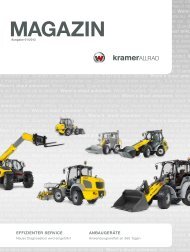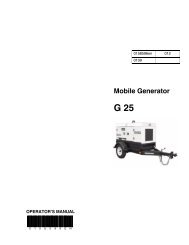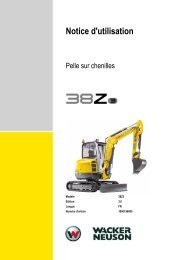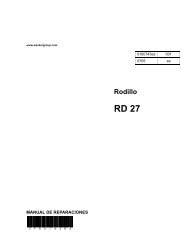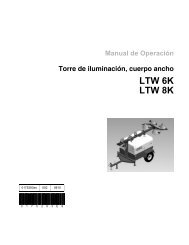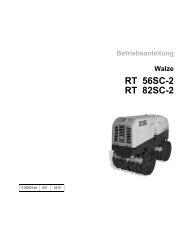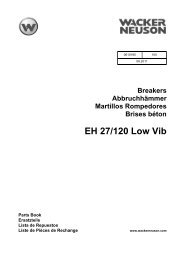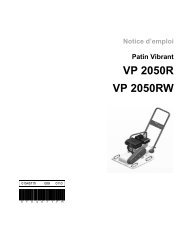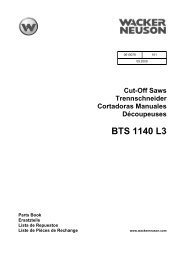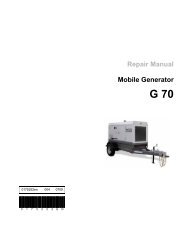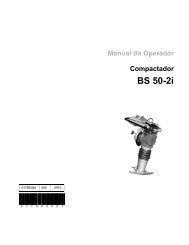Operation - Wacker Neuson
Operation - Wacker Neuson
Operation - Wacker Neuson
You also want an ePaper? Increase the reach of your titles
YUMPU automatically turns print PDFs into web optimized ePapers that Google loves.
Operator´s Manual<br />
0226267en 002<br />
03.2010<br />
Vibratory plate<br />
DPU 5545He
Manufacturer<br />
<strong>Wacker</strong> <strong>Neuson</strong> SE<br />
Preußenstraße 41<br />
80809 München<br />
www.wackerneuson.com<br />
Tel.: +49-(0)89-354 02-0<br />
Fax: +49-(0)89-354 02-390<br />
Translation of the original operator’s manual in German
1 Foreword<br />
1 Foreword<br />
This operator's manual contains information and procedures for the safe operation<br />
and maintenance of your <strong>Wacker</strong> <strong>Neuson</strong> machine. In the interest of your<br />
own safety and to prevent accidents, you should carefully read through the safety<br />
information, familiarize yourself with it and observe it at all times.<br />
This operator's manual is not a manual for extensive maintenance and repair<br />
work. Such work should be carried out by <strong>Wacker</strong> <strong>Neuson</strong> service or authorized<br />
specialists.<br />
The safety of the operator was one of the most important aspects taken into consideration<br />
when this machine was designed. Nevertheless, improper use or incorrect<br />
maintenance can pose a risk. Please operate and maintain your <strong>Wacker</strong><br />
<strong>Neuson</strong> machine in accordance with the instructions in this operator's manual.<br />
Your reward will be troublefree operation and a high degree of availability.<br />
Defective machine parts must be replaced immediately!<br />
Please contact your <strong>Wacker</strong> <strong>Neuson</strong> representative if you have any questions<br />
concerning operation or maintenance.<br />
All rights reserved, especially reproduction and distribution rights.<br />
Copyright 2010 <strong>Wacker</strong> <strong>Neuson</strong> SE<br />
No part of this publication may be reproduced in any form or by any means, electronic<br />
or mechanical, including photocopying, without the expressed written permission<br />
of <strong>Wacker</strong> <strong>Neuson</strong>.<br />
Any type of reproduction, distribution or storage on data media of any type and<br />
form not authorized by <strong>Wacker</strong> <strong>Neuson</strong> represents an infringement of copyright<br />
and will be prosecuted.<br />
We expressly reserve the right to make technical modifications – even without<br />
special notice – which aim at further improving our machines or their safety standards.<br />
3
Table Of Contents<br />
1. Technical Data 22<br />
2. Description 24<br />
2.1 Dimensions ..........................................................................................24<br />
2.2 Max. admissible inclination ..................................................................24<br />
2.3 Description of function .........................................................................24<br />
3. Transport to work site /Recommendations on compaction 27<br />
3.1 Transport to work site ..........................................................................27<br />
3.2 Recommendations on compaction ......................................................28<br />
4. <strong>Operation</strong> 29<br />
4.1 Starting ................................................................................................29<br />
4.2 Forward and reverse motion ...............................................................30<br />
4.3 Switching off ........................................................................................31<br />
4.4 Compaction without extension plates ..................................................31<br />
4.5 Emergency start by hand ....................................................................31<br />
4.6 Mechanical oil pressure control ...........................................................33<br />
4.7 Starting with external battery etc. ........................................................34<br />
4.8 Additional notes on starting at very low temperatures! ........................35<br />
5. Maintenance 36<br />
5.1 Maintenance schedule ........................................................................36<br />
5.2 Engine oil .............................................................................................37<br />
5.3 Batterry ................................................................................................38<br />
5.4 Hydraulic control ..................................................................................39<br />
5.5 Exciter .................................................................................................40<br />
5.6 Exciter V-belt .......................................................................................41<br />
6. Faults 42<br />
4
5<br />
Table Of Contents<br />
6.1 Forward speed too low ........................................................................42<br />
6.2 Reverse speed too low ........................................................................42<br />
6.3 No reverse motion ...............................................................................42<br />
6.4 Loss of hydraulic oil .............................................................................42<br />
6.5 The charge control lamp will not extinguish ........................................43<br />
6.6 Engine does not start ..........................................................................43
Table Of Contents<br />
6
DPU 2 Safety<br />
2 Safety<br />
2.1 Principle<br />
State of the art<br />
This machine has been constructed with state-of-the-art technology according to<br />
the recognized rules of safety. Nevertheless, when used improperly, dangers to<br />
the life and limb of the operator or to third persons or damage to the machine or<br />
other materials cannot be excluded.<br />
Proper use<br />
The machine must only be used for the following purposes:<br />
Compaction of soils.<br />
Compaction of asphalt.<br />
Shaking in of paving stones.<br />
The machine may not be used for the following purposes:<br />
Compaction of intensely cohesive soils.<br />
Compaction of frozen soils.<br />
Compaction of hard, non-compactable soils.<br />
Compaction of soils that are not capable of bearing a load.<br />
Its proper use also includes the observance of all instructions contained in this<br />
operator's manual as well as complying with the required service and maintenance<br />
instructions.<br />
Any other use is regarded as improper. Any damage resulting from improper use<br />
will void the warranty and the liability on behalf of the manufacturer. The operator<br />
assumes full responsibility.<br />
Structural modifications<br />
Never attempt to modify the machine without the written permission of the manufacturer.<br />
To do so will endanger your safety and the safety of other people! In<br />
addition, this will void the warranty and the liability on behalf of the manufacturer.<br />
Especially the following are cases of structural modifications:<br />
Opening the machine and the permanent removal of components from<br />
<strong>Wacker</strong> <strong>Neuson</strong>.<br />
Installing new components which are not from <strong>Wacker</strong> <strong>Neuson</strong> and not equivalent<br />
to the original parts in design and quality.<br />
Installation of accessories which are not from <strong>Wacker</strong> <strong>Neuson</strong>.<br />
It is no problem to install spare parts from <strong>Wacker</strong> <strong>Neuson</strong>.<br />
It is no problem to install accessories that are available in the <strong>Wacker</strong> <strong>Neuson</strong><br />
product range of your machine. Please refer to the installation regulations in this<br />
operator's manual.<br />
Operator's manual 7
2 Safety DPU<br />
Requirements for operation<br />
The ability to operate the machine safely requires:<br />
Proper transport, storage and setup.<br />
Careful operation.<br />
Careful service and maintenance.<br />
<strong>Operation</strong><br />
Operate the machine only as intended and only when in proper working condition.<br />
Operate the machine in a safety-conscious manner with all safety devices attached<br />
and enabled. Do not modify or disable any safety devices.<br />
Before starting operation, check that all control and safety devices are functioning<br />
properly.<br />
Never operate the machine in a potentially explosive environment.<br />
Supervision<br />
Never leave the machine running unattended!<br />
Maintenance<br />
Regular maintenance work is required in order for the machine to operate properly<br />
and reliably over time. Failure to perform adequate maintenance reduces the<br />
safety of the machine.<br />
Strictly observe the prescribed maintenance intervals.<br />
Do not use the machine if it requires maintenance or repairs.<br />
Malfunctions<br />
If you detect a malfunction, you must shut down and secure the machine immediately.<br />
Eliminate the malfunctions that impair safety immediately!<br />
Have damaged or defective components replaced immediately!<br />
For further information, refer to chapter Troubleshooting.<br />
Spare parts, accessories<br />
Use only spare parts from <strong>Wacker</strong> <strong>Neuson</strong> or such that are equivalent to the original<br />
parts in design and quality.<br />
Only use accessories from <strong>Wacker</strong> <strong>Neuson</strong>.<br />
Non-compliance will exempt the manufacturer from all liability.<br />
8 Operator's manual
DPU 2 Safety<br />
Exclusion of liability<br />
<strong>Wacker</strong> <strong>Neuson</strong> will refuse to accept liability for injuries to persons or for damage<br />
to materials in the following cases:<br />
Structural modifications.<br />
Improper use.<br />
Failure to comply with this operator's manual.<br />
Improper handling.<br />
Using of spare parts which are not from <strong>Wacker</strong> <strong>Neuson</strong> and not equivalent<br />
to the original parts in design and quality.<br />
Using of accessories which are not from <strong>Wacker</strong> <strong>Neuson</strong>.<br />
Operator's manual<br />
Always keep the operator's manual near the machine or near the worksite for<br />
quick reference.<br />
If you have misplaced the operator's manual or require an additional copy, contact<br />
your <strong>Wacker</strong> <strong>Neuson</strong> representative or download the operator's manual from<br />
the Internet (www.wackerneuson.com).<br />
Always hand over this operator's manual to other operators or to the future owner<br />
of the machine.<br />
Country-specific regulations<br />
Observe the country-specific regulations, standards and guidelines in reference<br />
to accident prevention and environmental safety, for example those pertaining to<br />
hazardous materials and wearing protective gear.<br />
Complement the operator's manual with additional instructions taking into account<br />
the operational, regulatory, national or generally applicable safety guidelines.<br />
Operator's controls<br />
Always keep the operator's controls of the machine dry, clean and free of oil or<br />
grease.<br />
Operating elements such as ON/OFF switch, gas handles etc. may not be<br />
locked, manipulated or changed without authorization.<br />
Cleaning<br />
Always keep the machine clean and be sure to clean it each time you have finished<br />
using it.<br />
Do not use gasoline or solvents. Danger of explosion!<br />
Do not use high pressure washers. Permeating water can damage the machine.<br />
When electrical equipment is present, this can pose a serious injury risk from<br />
electric shocks.<br />
Operator's manual 9
2 Safety DPU<br />
Checking for signs of damage<br />
Inspect the machine when it is switched off for any signs of damage at least once<br />
per work shift.<br />
Do not operate the machine if there is visible damage or defects.<br />
Have any damage or defects eliminated immediately.<br />
2.2 Qualification of the operating personnel<br />
Operator qualifications<br />
Only trained personnel are permitted to start and operate the machine. The following<br />
rules also apply:<br />
You are at least 18 years of age.<br />
You are physically and mentally fit.<br />
You have received instruction on how to independently operate the machine.<br />
You have received instruction in the proper use of the machine.<br />
You are familiar with required safety devices.<br />
You are authorized to start machines and systems in accordance with the<br />
standards governing safety.<br />
Your company or the operator has assigned you to work independently with<br />
this machine.<br />
Incorrect operation<br />
Incorrect operation or misuse by untrained personnel can endanger the health<br />
and safety of the operator or third persons and also cause machine and material<br />
damage.<br />
Operating company responsibilities<br />
The operating company must make the operator's manual available to the operator<br />
and ensure that the operator has read and understood it.<br />
Work recommendations<br />
Please observe the recommendations below:<br />
Work only if you are in a good physical condition.<br />
Work attentively, particularly as you finish.<br />
Do not operate the machine when you are tired.<br />
Carry out all work calmly, circumspectly and carefully.<br />
Never operate the machine under the influence of alcohol, drugs or medication.<br />
This can impair your vision, reactions and your judgment.<br />
Work in a manner that does not endanger others.<br />
Ensure that no persons or animals are within the danger zone.<br />
10 Operator's manual
DPU 2 Safety<br />
2.3 Protective gear<br />
Work clothing<br />
Clothing should be appropriate, i.e. should be close-fitting but not restrict your<br />
movement.<br />
When on construction sites, do not wear long hair loosely, loose clothing or jewelry<br />
including rings. These objects can easily get caught or be drawn in by moving<br />
machine parts.<br />
Only wear clothing made of material that is not easily flammable.<br />
Personal protective gear<br />
Wear personal protective gear to avoid injuries or health hazards:<br />
Non-skid, hard-toed shoes.<br />
Work gloves made of durable material.<br />
Overalls made of durable material.<br />
Hard hat.<br />
Ear protection.<br />
Ear protection<br />
This machine generates noise that exceeds the country-specific permissible<br />
noise levels (individual rating level). It may therefore be necessary to wear ear<br />
protection. You can find the exact value in the chapter Technical Data.<br />
When wearing ear protection while working, you must pay attention and exercise<br />
caution because your hearing is limited, e.g. in case someone screams or a signal<br />
tone sounds.<br />
<strong>Wacker</strong> <strong>Neuson</strong> recommends that you always wear ear protection.<br />
2.4 Transport<br />
Switching off the machine<br />
Before you transport the machine, it must be switched off, and the engine must<br />
be given sufficient time to cool down.<br />
Center pole in transport position<br />
Before commencing transport, move the center pole to the transport position. Let<br />
the center pole latch into its lock.<br />
Observing hazardous materials regulations<br />
Observe the national safety guidelines and the hazardous materials regulations<br />
that apply to the respective means of transportation.<br />
Operator's manual 11
2 Safety DPU<br />
Lifting<br />
When lifting the machine, observe the following instructions:<br />
Designate a skilled person to guide you for the lifting procedure.<br />
You must be able to see or hear this person.<br />
Use only suitable and certified hoisting gear, lifting tackle and load-bearing<br />
equipment with sufficient lifting capacities.<br />
Only use the attachment points described in the operator's manual.<br />
Attach the machine securely to the hoisting gear.<br />
Ensure that no one is nearby or under the machine.<br />
Do not climb onto the machine.<br />
Loading the machine<br />
Loading ramps must be able to bear the load and be in a stable position.<br />
Make sure that no one can be endangered if the machine slips away or tips over<br />
or if machine parts suddenly move upward or downward.<br />
Put the operating controls and moving parts in their transport position.<br />
Secure the machine with load-securing straps so that it cannot tip over, fall down<br />
or slide away. Only use the attachment points described in the operator's manual.<br />
Transport vehicle<br />
Use only suitable transport vehicles with sufficient load-carrying capacity and<br />
suitable tie-down lugs.<br />
Transporting the machine<br />
Secure the machine on the transport device against tilting, falling or slipping.<br />
Only use the lashing points listed in the operating instructions.<br />
Also observe the country-specific regulations, standards and guidelines.<br />
Restarting<br />
Machines, machine parts, accessories or tools that were detached for transport<br />
purposes must be re-mounted and fastened before restarting.<br />
Only operate in accordance with the operating instructions.<br />
2.5 Operating safety<br />
Explosible environment<br />
Never operate the machine in a potentially explosive environment.<br />
12 Operator's manual
DPU 2 Safety<br />
Work environment<br />
Familiarize yourself with your work environment before you start work. This includes<br />
e.g. the following items:<br />
Obstacles in the work and traffic area.<br />
Load-bearing capacity of the ground.<br />
The measures needed to cordon off the construction site from public traffic in<br />
particular.<br />
The measures needed to secure walls and ceilings.<br />
Options available in the event of an accident.<br />
Safety in the work area<br />
When working with the machine especially pay attention to the following points:<br />
Electric lines or pipes in work area.<br />
Gas lines or water lines in the work area.<br />
Starting the machine<br />
Observe the safety information and warning notices located on the machine and<br />
in the operator's manual.<br />
Never attempt to start a machine that requires maintenance or repairs.<br />
Start the machine as directed in the operator's manual.<br />
Vertical stability<br />
Always ensure that the machine is vertically stable and cannot tip over, roll or<br />
slide away.<br />
Proper operator position<br />
Do not leave the proper operator position while operating the machine.<br />
The proper operator position is behind the center pole of the machine.<br />
Leaving the danger area<br />
Injury may be caused by moving machines or flying materials.<br />
Ensure that other persons observe a minimum safety distance of 2 m from the<br />
machine.<br />
Caution with movable parts<br />
Keep your hands, feet and loose clothing away from moving or rotating machine<br />
parts. Parts of your body being pulled in or crushed can cause serious injuries.<br />
Operator's manual 13
2 Safety DPU<br />
Switching off the machine<br />
Switch off the engine in the following situations:<br />
Before breaks.<br />
If you are not using the machine.<br />
Store the machine in such a way that it cannot tilt, fall or slip.<br />
Storage location<br />
After operation, allow the machine to cool and then store it in a sealed-off, clean<br />
and dry location protected against frost and inaccessible to children.<br />
Not using starter sprays<br />
Highly flammable starter sprays pose a fire hazard.<br />
Do not use any starter sprays.<br />
Starter sprays are highly flammable and can cause backfiring and engine damage.<br />
Vibrations<br />
When manually operated machines are intensively used, long-term damage<br />
caused by vibrations cannot be precluded.<br />
Observe the relevant legal instructions and guidelines to minimize vibration<br />
stress.<br />
Details on vibration stress associated with the machine can be found in the chapter<br />
Technical Data.<br />
2.6 Safety during the operation of vibratory plates<br />
Integrated driving mechanism<br />
Machines with integrated driving mechanism must not be set down or stored on<br />
the transport device. The driving mechanism is only intended for transport.<br />
Belt guard<br />
Never operate the machine without a belt guard!<br />
Exposed belts and belt pulleys are dangerous and can cause serious injuries if<br />
they pull in any part of your body or if parts are ejected.<br />
Danger of falling over<br />
Operate the machine so that it cannot tip over or fall down from bordered areas,<br />
edges and steps.<br />
Load-carrying capacity of the ground<br />
Keep in mind that the load-carrying capacity of the earth to be compressed or<br />
bed can be greatly reduced by the effects of vibration, for example near slopes.<br />
14 Operator's manual
DPU 2 Safety<br />
Avoiding crushing<br />
When operating the machine, pay particular attention to avoid being squeezed<br />
between the machine and an obstacle. Always look in the direction of travel!<br />
Compacting on slopes<br />
The following points must be observed if you plan to compact inclined surfaces<br />
(slopes, escarpments):<br />
Always stand above the machine on a slope.<br />
Start at the bottom of a slope (slopes that can be easily managed in an upward<br />
direction can be safely traveled in a downward direction also).<br />
Never stand in a position where the machine could possibly fall. A slipping or<br />
tipping machine can cause serious injuries.<br />
Not exceeding the maximum tilt position<br />
Do not exceed the maximum tilt position (see chapter Technical Data).<br />
Only operate the machine at maximum tilt for short periods of time.<br />
If you exceed the maximum tilt, the engine lubrication system will fail and thus<br />
inevitably damage important engine parts.<br />
Check the effects of vibration<br />
Compacting work in the vicinity of buildings can lead to structural damage. For<br />
this reason you must always check the possible effects of vibrations on surrounding<br />
buildings in the run-up to work.<br />
You must take the following points into special consideration when evaluating the<br />
effects of vibration:<br />
Vibration behavior, sensitivity and resonance frequency of surrounding buildings.<br />
Distance of the buildings from the vibrationsite (= worksite).<br />
Condition of the soil.<br />
You may need to carry out measurements to determine the vibration speed.<br />
You must also comply with the relevant guidelines and regulations, particularly<br />
DIN 4150-3.<br />
The foundation must also have sufficient load-bearing capacity to withstand the<br />
compaction energy. In case of doubt involve a soil mechanics specialist in the<br />
evaluation.<br />
<strong>Wacker</strong> <strong>Neuson</strong> is not liable for any structural damage.<br />
Operator's manual 15
2 Safety DPU<br />
2.7 Safety during the operation of combustion engines<br />
Checking for signs of damage<br />
Check the engine while switched off for leaks and cracks in the fuel line, tank and<br />
fuel cap at least once per work shift.<br />
Do not operate the machine if there is visible damage or defects.<br />
Have any damage or defects eliminated immediately.<br />
Dangers during operation<br />
Combustion engines can be dangerous, particularly during operation and when<br />
refueling.<br />
Read and follow all safety instructions. Otherwise there is a risk of personal injury<br />
and/or damage to property!<br />
Do not start the engine near spilt fuel or if you smell fuel – this may cause an explosion!<br />
Remove the machine from such areas.<br />
Remove the spilt fuel immediately!<br />
Not changing the engine speed<br />
Do not change the preset engine speed, as this may cause engine damage.<br />
Preventing fires<br />
Open flames and smoking are strictly prohibited in the immediate vicinity of the<br />
machine.<br />
Make sure that waste, such as paper, dry leaves or grass do not accumulate<br />
around the exhaust muffler. The waste materials may ignite.<br />
16 Operator's manual
DPU 2 Safety<br />
Safety precautions when refueling<br />
Please observe the following safety-relevant instructions when refueling:<br />
Do not refuel near open flames.<br />
Do not smoke.<br />
Turn off the engine before refueling and allow it to cool down.<br />
Refuel in a well-ventilated environment.<br />
Wear fuel-proof protective gloves and, if there is the possibility of spraying,<br />
protective goggles and clothing.<br />
Do not inhale fuel vapors.<br />
Avoid skin and eye contact with fuel.<br />
For refueling, use clean tools such as a hopper.<br />
Do not spill fuel, especially onto hot parts.<br />
Remove any spilt fuel immediately.<br />
Use the correct fuel grade.<br />
Do not mix fuel with other liquids.<br />
Fill the tank only up to the maximum marking. If there is no Maximum marking,<br />
do not fill up the tank completely.<br />
Lock the fuel cap securely after refueling.<br />
<strong>Operation</strong> in closed rooms<br />
In closed or partially closed rooms such as tunnels, drifts or deep trenches, ensure<br />
sufficient ventilation and extraction by, for example, providing a powerful exhaust<br />
air fan.<br />
Danger of poisoning! Do not inhale exhaust fumes. They contain toxic carbon<br />
monoxide that can lead to unconsciousness or death.<br />
Caution with hot parts<br />
Do not touch any hot parts such as the engine block or exhaust muffler during<br />
operation or directly afterwards. These parts can become very hot and cause severe<br />
burns.<br />
Cleaning the engine<br />
Clean the engine when it is cool to remove any dirt.<br />
Do not use gasoline or solvents. Danger of explosion!<br />
Notes on the EPA engine<br />
Caution<br />
This machine is equipped with an EPA-certified engine.<br />
Modifying the motor speed influences the EPA certification and emission. The<br />
motor may only be set by a skilled technician.<br />
For more detailed information, contact your nearest motor or <strong>Wacker</strong> <strong>Neuson</strong><br />
representative.<br />
Operator's manual 17
2 Safety DPU<br />
Health hazard due to exhaust fumes<br />
Warning<br />
The engine's exhaust fumes contain chemicals which are known to the State of<br />
California to cause cancer, congenital defects or other reproductive anomalies.<br />
2.8 Safety during the operation of hydraulic machines<br />
Hydraulic oil<br />
Hydraulic oil is harmful to health.<br />
Wear safety glasses and safety gloves when handling hydraulic oil.<br />
Avoid direct skin contact with hydraulic oil. Remove hydraulic oil from the skin immediately<br />
with soap and water.<br />
Make sure that no hydraulic oil comes gets in the eyes or on the body. See a physician<br />
immediately if hydraulic oil gets into the eyes or is swallowed.<br />
Do not eat and drink while handling hydraulic oil.<br />
Make sure to have extreme cleanliness. Contamination of the hydraulic oil with<br />
dirt or water can cause premature wear or failure of the machine.<br />
Dispose of left over and spilled hydraulic oil according to the applicable regulations<br />
for environmental protection.<br />
2.9 Maintenance<br />
Maintenance work<br />
Service and maintenance work must only be carried out to the extent described<br />
in these operating instructions. All other procedures must be performed by your<br />
<strong>Wacker</strong> <strong>Neuson</strong> representative.<br />
For further information, refer to chapter Maintenance.<br />
Switching off the engine<br />
Before carrying out care or maintenance work, switch off the engine and allow it<br />
to cool down.<br />
For gasoline powered engines, you must pull off the spark plug cap.<br />
Disconnecting the battery<br />
For machines with electric starter, you must disconnect the battery before working<br />
on the electronic parts.<br />
Using only a <strong>Wacker</strong> <strong>Neuson</strong> battery<br />
Use only <strong>Wacker</strong> <strong>Neuson</strong> batteries to replace defective batteries, see chapter<br />
Technical Data.<br />
Only the <strong>Wacker</strong> <strong>Neuson</strong> battery is vibration resistant and thus suitable for the<br />
high vibratory stresses.<br />
18 Operator's manual
DPU 2 Safety<br />
Working on the battery<br />
Always take the following safety measures when working with the battery:<br />
No fire, sparks, or smoking while working with batteries.<br />
Batteries contain corrosive acid. Use acid-proof protective gloves and protective<br />
goggles when working with batteries.<br />
Avoid short circuits due to improper connection or bypassing with tools.<br />
Disconnect the negative terminal first when disconnecting the battery.<br />
Connect the positive terminal first when connecting the battery.<br />
Re-fasten terminal covers after connecting the battery.<br />
Assembling safety devices<br />
If it was necessary to dismantle safety devices, they must be reassembled and<br />
checked immediately after completing maintenance work.<br />
Always tighten loosened screw connections, complying with prescribed starting<br />
torque.<br />
Handling operating fluids safely<br />
Observe the following points when handling operating fluids, e.g. fuels, oils,<br />
greases, coolants etc.:<br />
Always wear personal safety clothing.<br />
Avoid skin and eye contact with operating fluids.<br />
Do not inhale or swallow operating fluids.<br />
In particular, avoid contact with hot operating fluids. Burn and scalding hazard.<br />
Dispose of replaced or spilled operating fluids according to the applicable<br />
regulations for environmental protection.<br />
If operating fluids escape from the machine, cease operation of the machine<br />
and have it repaired immediately by your <strong>Wacker</strong> <strong>Neuson</strong> representative.<br />
Operator's manual 19
2 Safety DPU<br />
2.10 Safety and information labels<br />
Your machine has adhesive labels containing the most important instructions<br />
and safety information.<br />
Make sure that all the labels are kept legible.<br />
Replace any missing or illegible labels.<br />
The item numbers for the labels are in the parts book.<br />
Pos. Label Description<br />
1 Wear personal protective gear to avoid<br />
injuries or health hazards:<br />
Ear protection.<br />
Read the operator's manual before startup.<br />
2 If the machine falls, it can cause severe<br />
crushing injuries.<br />
Only lift the machine with certified<br />
hoist and lifting tackle (safety load<br />
hook).<br />
Do not lift the machine with the excavator<br />
shovel by the central suspension.<br />
Do not lift the machine with a forklift<br />
by the central suspension.<br />
3 Guaranteed sound power level.<br />
4 Start-Stop.<br />
0219259<br />
20 Operator's manual<br />
0219175<br />
0216633
DPU 2 Safety<br />
Pos. Label Description<br />
5 If the machine falls, it can cause severe<br />
crushing injuries.<br />
Do not lift the machine by the guide<br />
handle or the center pole.<br />
0220000<br />
6 US machines Warning<br />
WARNING<br />
WARNUNG<br />
ADVERTENCIA<br />
0219261<br />
ADVERTISSEMENT<br />
0219176<br />
Operator's manual 21
Technical Data<br />
1. Technical Data<br />
TD00692GB.fm 22<br />
DPU 5545Heap DPU 5545He<br />
Item no. 0610353 0610351, 0610402<br />
Operating weight<br />
Forward/reverse speed<br />
kg:<br />
Surface compaction performance<br />
m 2 /h:<br />
444 416<br />
m/min: 24<br />
1109 972<br />
Power transmission From drive engine directly to exciter unit via<br />
automatic centrifugal and V-belts<br />
Exciter<br />
Vibrations<br />
Centrifugal force<br />
Hz:<br />
kN:<br />
Multigrade oil Fuchs Titan Unic 10W40 MC (SAE 10W40)<br />
Oil quantity<br />
Drive motor<br />
Piston displacement<br />
Engine speed<br />
Rated power (*)<br />
l:<br />
cm 3 :<br />
min -1 :<br />
kW:<br />
69<br />
50<br />
0,75<br />
Air-colled single-cylinder 4 stroke diesel engine with electric<br />
starter<br />
445<br />
2850 - 3060<br />
Fuel Diesel<br />
Fuel consumption<br />
Tank capacity<br />
l/h:<br />
l:<br />
Oil Fuchs Titan Unic 10W40 MC (SAE 10W40)<br />
Oil quantity<br />
Electrical system<br />
l:<br />
6,4<br />
1,8<br />
5,0<br />
1,2
TD00692GB.fm 23<br />
Technical Data<br />
Battery Special <strong>Wacker</strong> <strong>Neuson</strong>-battery for vibro plates<br />
- 12 V - 55 Ah<br />
Alternator Rotary current generator with electronic regulator<br />
and rectifier<br />
Charging rate max.<br />
Charging voltage<br />
A:<br />
V:<br />
Starter Starter motor<br />
D.C.<br />
Hydraulic control<br />
V:<br />
Hydraulic oil Fuchs Renolin MR 520<br />
Oil quantity<br />
Special lubricating grase<br />
l:<br />
L PA :<br />
The weighted effec-tive acceleration<br />
value, determined according to<br />
EN ISO 5349<br />
Uncertainty K<br />
m/s 2 :<br />
m/s 2 :<br />
DPU 5545Heap DPU 5545He<br />
(*) In accordance with the installed useful outlet power according to Directive 2000/14/<br />
EG.<br />
26<br />
14<br />
12<br />
0,4<br />
94 dB(A)<br />
3,6<br />
1,0
Description<br />
2. Description<br />
2.1 Dimensions<br />
2.2 Max. admissible inclination<br />
T00994GB.fm 24
2.3 Description of function<br />
T00994GB.fm 25<br />
Description<br />
2.3.1 The vibration required for compaction is produced by the exciter (13)<br />
which is firmly joined to the lower mass (5). This exciter (13) is<br />
designed as a central vibrator with aligned vibrations. Such a principle<br />
permits the direction of vibration to be changed by turning the eccentric<br />
weights (15). In this way an infinitely variable transition between<br />
vibration in forward motion , at standstill and in reverse motion is<br />
possible. This process is hydraulically controlled with the operating<br />
control handle (6) on the centre pole head (7).<br />
Forwards Standstill Reverse<br />
2.3.2 The drive engine (1) anchored to the upper mass (4) drives the exciter<br />
(13). The torque is transmitted by means of a friction connection<br />
through the centrifugal clutch (11) and the exciter V-belt (12).
Description<br />
2.3.3 The centrifugal clutch (11) interrupts flow of power to the exciter (13)<br />
at low engine speed and thus permits perfect idling of the drive engine<br />
(1).<br />
2.3.4 The automatic V-belt pulley (10) combined with the centrifugal clutch<br />
(11) ensures optimum tension of the exciter V-belt (12) during<br />
operation and relief of the tension of the exciter V-belt (12) when the<br />
machine is being relocated or transported.<br />
2.3.5 Moreover, the automatic V-belt pulley (10) automatically adapts to the<br />
V-belt flanks in line with the wear and thus makes the entire drive from<br />
the engine (1) to the exciter (13) maintenance-free (see chapter<br />
Exciter V-belt).<br />
2.3.6 The speed of the drive engine (1) can be infinitely varied by remote<br />
control on the throttle control lever (8). The upper (4) and lower (5)<br />
masses are connected to each other by 4 vibration-damping rubber<br />
metal shock mounts (14). This damping system prevents the very high<br />
frequencies from being transmitted to the upper mass (4). As a result<br />
the functionability of the drive engine (1) is retained in spite of the high<br />
compaction performance. The drive engine (1) works on the diesel<br />
principle; it is started electrically by a pinion starter (3), draws in the<br />
combustion air through an air filter, dry (9) and is air-colled.<br />
2.3.7 To facilitate the starting procedure (at very low temperatures, with<br />
hand start) the drive engine (1) has an automatic decompression<br />
mechanism (2). It ensures that compression is very low during the<br />
cranking operation but steadily increases after a few revolutions when<br />
it then switches over to full compression.<br />
T00994GB.fm 26
Transport to work site /Recommendations on compaction<br />
3. Transport to work site /Recommendations on compaction<br />
3.1 Transport to work site<br />
Conditions:<br />
∗ To transport the vibration plate, only use suitable lifting equipment with<br />
a minimum load-bearing capacity of 500 kg.<br />
∗ Always switch off engine before transporting the machine!<br />
∗ Vertically set guide handle head and lock into place.<br />
∗ Only attach suitable tackle at the central lifting point (18a) provided.<br />
The central lifting point is located exactly above the centre of gravity of<br />
the machine. The central lifting point can be displaced rearwards<br />
(18b), given an application in which the height of the machine is of<br />
importance (torque wrench setting = 85 Nm).<br />
∗ During transport on the loading area of a vehicle, tie down the vibration<br />
plate using the lugs (17).<br />
Note: Also overve the regulations in safety instructions.<br />
T00995GB.fm 27
Transport to work site /Recommendations on compaction<br />
3.2 Recommendations on compaction<br />
3.2.1 Ground conditions<br />
The max. compaction depth depends on several factors relating to the<br />
ground condition, such as moisture, grain distribution etc,<br />
it is therefore not possible to specify exact values.<br />
Recommendation: In each case determine the max. compaction<br />
depth with compaction tests and soil samples.<br />
3.2.2 Compaction on slopes<br />
The following points are to be observed when compacting on sloped<br />
surfaces (slopes, embankments):<br />
∗ Only approach gradients from the bottom (a gradient which can be<br />
easily overcome upwards, can also be compacted downwards without<br />
any risk).<br />
∗ The operator must never stand in the direction of descent.<br />
∗ The max. gradient of 25o must not be exceeded.<br />
A tilt in excess of this angle could lead to a stopping of the engine due<br />
to the automatic low oil shut-off system. A restarting of the engine can<br />
only take place after the valve lever at the oil filter housing has been<br />
actuated once.<br />
T00995GB.fm 28<br />
Right ! Wrong!
4. <strong>Operation</strong><br />
4.1 Starting<br />
4.1.1 Conditions:<br />
T00996GB.fm 29<br />
<strong>Operation</strong><br />
Oil:<br />
Check oil level with oil dipstick (21), if necessary top up with Fuchs<br />
Titan Unic 10W40 MC through oil filler neck (19).<br />
Fuel:<br />
When pouring diesel fuel into the filler neck (20), maintain absolute<br />
cleanliness. Impurities in the fuel can cause breakdowns in the<br />
injection system and premature clogging of the fuel filter.<br />
Air filter:<br />
Clean air filter dry, dusty conditions.<br />
4.1.2 Once these points have been observed, you can start the engine as<br />
follows:
<strong>Operation</strong><br />
1. Turn the throttle control lever (8) clockwise into full load position.<br />
2. In extreme cold also activate the automatic decompression (2).<br />
3. Turn ignition switch key (22) to operating position; then push in<br />
starter button and hold until engine is running.<br />
Wait until the engine stops before repeating the starting procedure.<br />
4. Turn throttle control lever (8) into idling position, allow engine to<br />
warm up for 7 minutes at idling speed.<br />
Note: Do not activate automatic decompression lever while the engine is<br />
running.<br />
4.2 Forward and reverse motion<br />
The engine speed can be infinitely varied on the throttle control lever.<br />
The direction of travel is determinet with the shift lever (6).<br />
Depending on the position of the shift lever (6), the vibration plate<br />
compacts in forward direction, at standstill or in reverse direction.<br />
The forward and reverse speeds can be varied by selecting<br />
intermediate positions of the shift lever (6) or the machine can be<br />
employed for particularly intensive compaction at standstill.<br />
Forwards<br />
T00996GB.fm 30<br />
Standsill Reverse
4.3 Switching off<br />
T00996GB.fm 31<br />
<strong>Operation</strong><br />
Never switch off the engine with the automatic decompression (2) as<br />
this inevitably results in damage to the valve drive and decompression<br />
mechanism.<br />
1. Move the throttle control lever (8) to the stop.<br />
2. When the engine is at a standstill, turn the ignition key (22) to the<br />
Stop position and pull out, control lamp goes off.<br />
4.4 Compaction without extension plates<br />
If the vibration plates is used without extension plates, screw set of<br />
protective screws (8 pes) into the threaded boreholes situated in the<br />
lower mass, in order to avoid threads from being damaged.<br />
4.5 Emergency start by hand<br />
An automatic decompression (2) is provided to facilitate starting. It<br />
ensures that there is only a little compression pressure during the first<br />
few revolutions of the crankshaft. After several revolutions it<br />
automatically switches over to the full compression pressure.
<strong>Operation</strong><br />
1. Turn the throttle control lever (8) to the full load position.<br />
2. Following the direction of long arrow, turn the decompression lever<br />
until the stop position. At this point automatic decompression lever<br />
engages with an audible click, and the engine is ready to start.<br />
3. Insert crank (24) into the bushing.<br />
4. After having engaged the automatic decompression system to the<br />
stop position, the engine will require five full turns of the crank until<br />
the engine regains its compression and fires up. If for any reason<br />
less than five turns are required for the starting procedure, turn the<br />
decompression lever back in the direction of the short dashed<br />
arrow. Each audible „click“ of the mechanism is equivalent to one<br />
turn less with the crank.<br />
5. Stand beside the engine (feet slightly apart), viewing in the forward<br />
direction.<br />
6. Place one hand on the machine an crank with the other hand.<br />
Keep a firm hold of the crank while cranking in order to avoid the risk<br />
of sudden slippage.<br />
7. Turn crank slowly at first until crank engages and then increase<br />
cranking speed.<br />
8. As soon as the engine is running, remove crank (24).<br />
9. Throttle control lever (8) in idling position; allow engine to warm up<br />
at idling speed for 2 - 3 minutes.<br />
T00996GB.fm 32
4.6 Mechanical oil pressure control<br />
T00996GB.fm 33<br />
<strong>Operation</strong><br />
It is necessary to reactivate the mechanical oil pressure control in the<br />
following cases:<br />
∗ after the initial filling - first filling - of the fuel tank or if the tank has run<br />
dry.<br />
∗ in the case of an automatic engine stop due to an inefficient engine oil<br />
supply.<br />
∗ after freeing the engine when in presence of extremely low<br />
temperatures.<br />
1. Fill up fuel tank.<br />
2. Check engine oil level.<br />
3. To activate depress hand lever for approx. 5 seconds.<br />
4. Hold down pin during approx. 5 seconds in the case of encapsulated<br />
engine versions.<br />
5. Simultaneously actuate hand lever a few times in the case of<br />
engines equipped with fuel pumps.<br />
6. Complete engine. Check to see that encapsulating elements seal<br />
correctly.<br />
Check oil level every 8 to 15 operating hours in spite of the mechanical<br />
oil pressure control.
<strong>Operation</strong><br />
4.7 Starting with external battery etc.<br />
4.7.1 Essential requirements for battery jumper cable:<br />
∗ Cable cross-section must be at least 16 mm2 . (2.5 sq. inches).<br />
∗ Clamps must be completely insulated with plastic.<br />
Only connect 12 Volt batteries. The on-board battery will explode if<br />
connected to a 24 Volt truck battery!<br />
The use of starter sprays is absolutely forbidden!<br />
4.7.2 Pay close attention to the following connection sequence when jumpstarting<br />
with an external battery:<br />
1. Connect the red jumper cable with the help of a clamp to the positive<br />
pole (1) of the discharged battery.<br />
2. Connect the other clamp of the red jumper cable to the plus pole (2)<br />
of the external (donor) battery.<br />
3. Connect the black jumper cablewith the help of a clamp to the<br />
negative pole (3) of the external battery.<br />
4. Connect the other clamp of the black jumper cable to a grounding<br />
point of the machine (4), e.g. to the engine block.<br />
4.7.3 Connect the black jumper cable to the negative pole (3) of the external<br />
battery.<br />
4.7.4 Disconnect the clamps in reverse order; first remove the black jumper<br />
cable, then the red one.<br />
T00996GB.fm 34<br />
External (donor) battery
4.8 Additional notes on starting at very low temperatures!<br />
T00996GB.fm 35<br />
<strong>Operation</strong><br />
Never use starting sprays or similar - they are forbidden because they<br />
are dangerous.<br />
Only use original <strong>Wacker</strong> crank.<br />
If cranking, is too slow, the engine can start running in the opposite<br />
direction of rotation.<br />
In this case the air is drawn in through the exhaust and the exhaust<br />
gases excape through the air filter. Risk of fire! Switch off engine and<br />
start it again.<br />
Free the engine by turning it approximately 10 to 20 times with the<br />
decompression lever in a central position. Then the engine is<br />
decompressed, but not ready to start. This intermediate position is<br />
used to turn the engine "free" when at very low temperatures. The<br />
turning resistance becomes appreciably lower owing to the change in<br />
viscosity of the oil film. At the same time you will hear that the nozzle<br />
of the fuel injection system is injecting cleanly (rattling).<br />
At very low temperatures (below -5o C), use the starting oil dosing<br />
device.<br />
Note: Do not use more than 2 doses as otherwise there is a risk<br />
of crank back-swing.
Maintenance<br />
5. Maintenance<br />
5.1 Maintenance schedule<br />
Component Maintenance work<br />
Drive engine First oil change and filter.<br />
Valve clearance<br />
Air filter<br />
T00997GB.fm 36<br />
Cold engine: Check valve clearance, and adjust if<br />
necessary.<br />
Inlet valve 0,1 mm - outlet valve 0,2 mm.<br />
Check dry type air filter - clean or replace filter<br />
cartridge if necessary (pay attention to the<br />
maintenance indication). daily<br />
Drive engine Check oil level, if nec. top up oil.<br />
Centre pole height<br />
setting, transport lock<br />
Regrease. weekly<br />
V-belt Check V-belt, if. nec. replace.<br />
Protective frame<br />
Central lifting point<br />
Check attachment screws for tight fit.<br />
Tow-bar head Check oil level, top up if necessary.<br />
Drive engine<br />
Exciter Oil change.<br />
Oil change, change oil filter.<br />
Keep cooling fins free of dirt, clean dry.<br />
Retighten all accessible screw connections.<br />
Battery Check acid level, if nec. top up with distilled water.<br />
Valve clearance<br />
Cold engine: Check valve clearance, and adjust<br />
if necessary.<br />
Inlet valve 0,1 mm - outlet valve 0,2 mm.<br />
Maintenance<br />
interval<br />
approx. 8 hours<br />
after initial start-up<br />
monthly<br />
every 250 h<br />
Fuel filter Change filter. every 500 h
5.2 Engine oil<br />
5.2.1 Check oil level:<br />
T00997GB.fm 37<br />
Maintenance<br />
∗ Check oil level with oil dipstick (21).<br />
∗ .If the oil level is too low, top up with Fuchs Titan Unic 10W40 MC<br />
though the filler neck (19).<br />
5.2.2 Changing the oil:<br />
1. Let engine warm up.<br />
2. Loosen oil drain screw.<br />
3. Loosen fastening screws and place bracket over used oil container.<br />
4. Remove oil drain screw and pour oil into container.<br />
5. Screw oil drain screw back in and refasten bracket.<br />
6. Pour in 1,0 l of oil through the filler neck (19).<br />
Take notice: Please pay attention to the corresponding environmental<br />
laws when disposing of used engine oil. We recommend you carry the<br />
oil in a container to a central collecting point for used oils. Do not pour<br />
used engine oil into the garbage nor into the sewer system, waste<br />
pipes or even on the ground.
Maintenance<br />
5.3 Batterry<br />
5.3.1 Check acid level:<br />
1. Remove battery cover.<br />
2. Check acid level, if necessary top up with distilled water.<br />
3. Secure battery cover.<br />
Do not close venting opening!<br />
Note: Only replace defective batteries with original <strong>Wacker</strong> batteries.<br />
Standard batteries are not suitable for the high vibration loads.<br />
4. When changing the battery:<br />
T00997GB.fm 38<br />
Removal: First disconnect negativ, then positive terminal of battery.<br />
Assembly. First connect positive, then negative terminal of battery.<br />
When using starting sprays etc., see chapter operation.
5.4 Hydraulic control<br />
5.4.1 Check oil level:<br />
1. Move centre pole into vertical position.<br />
2. Open filler bore (26).<br />
T00997GB.fm 39<br />
Maintenance<br />
3. Oil level must be at mark, if necesary top up with hydraulic oil Fuchs<br />
Renolin MR 520.<br />
4. Close filler bore (26).<br />
5.4.2 Venting hydraulic control:<br />
1. Remove apron (28) by undoing the screws (29).<br />
2. Move centre pole into vertical position, move shift lever (6) right into<br />
the reverse position, open filler bore (26).<br />
3. Loosen connecting screw (27).<br />
4. Slowly push the shift lever (6) into forward motion direction until<br />
hydraulic oil emerges bubblefree at the connection screw.<br />
5. Tighten connecting screw (27), mount apron (28).<br />
6. If necessary, top up with Fuchs Renolin MR 520, seal filler bore (26).
Maintenance<br />
5.5 Exciter<br />
5.5.1 Check oil level:<br />
1. Position vibration plate horizontally.<br />
2. Open filler bore (30).<br />
3. The oil level must reach the start of the thread of the filler bore.<br />
4. If necessary, pour in Fuchs Titan Unic 10W40 MC through filler bore<br />
(use funnel 0,75 l).<br />
5. Close filler bore. (Tightening torque 100 Nm)<br />
5.5.2 Changing the oil:<br />
1. Open filler bore (30).<br />
2. Tilt vibration plate and keep it tilted until the oil has run out.<br />
3. Place vibration plate in horizontal position.<br />
4. Pour in 0,75 l Fuchs Titan Unic 10W40 MC through the filler bore.<br />
5. Close filler bore. (Tightening torque 100 Nm)<br />
Do not pour in too much oil!<br />
Take notice: Please pay attention to the corresponding environmental<br />
laws when disposing of used engine oil. We recommend you carry the<br />
oil in a container to a central collecting point for used oils. Do not pour<br />
used engine oil into the garbage nor into the sewer system, waste<br />
pipes or even on the ground.<br />
T00997GB.fm 40<br />
Oil
5.6 Exciter V-belt<br />
T00997GB.fm 41<br />
Maintenance<br />
It is not necessary to retighten the V-belt owing to the use of the<br />
automatic centrifugal clutch.<br />
Should the V-belt width fall below 15,5 mm the V-belt must be<br />
replaced.<br />
5.6.1 Changing the exciter V-belt:<br />
1. Remove belt guard (31).<br />
2. Undo screw (32).<br />
3. Remove button (33), belleville spring (34), seal (35) and front<br />
segment of the V-belt pulley (10).<br />
4. Change exciter V-belt (12).<br />
5. Assemble the components in reverse order; make sure that the<br />
coloured marking on the pin (36) coincides with the marking on the<br />
V-belt pulley (10).<br />
Do not oil or grease clutch components (will damage the graphite<br />
bushes).
Faults<br />
6. Faults<br />
6.1 Forward speed too low<br />
6.2 Reverse speed too low<br />
6.3 No reverse motion<br />
6.4 Loss of hydraulic oil<br />
T00998GB.fm 42<br />
Cause Remedy<br />
To little hydraulic oil in the centre pole<br />
head.<br />
Top up hydraulic oil.<br />
Air in hydraulic control. Bleed system.<br />
Cause Remedy<br />
Too much hydraulic oil in centre pole<br />
head.<br />
Cause Remedy<br />
Correct oil level in accordance with<br />
mark.<br />
Mechanical fault. Contact <strong>Wacker</strong> <strong>Neuson</strong> service dept.<br />
Cause Remedy<br />
Leaks, hydraulic hose defective. Contact <strong>Wacker</strong> <strong>Neuson</strong> service dept.
6.5 The charge control lamp will not extinguish<br />
6.6 Engine does not start<br />
T00998GB.fm 43<br />
Cause Remedy<br />
Faults<br />
Dynamo defective. Contact <strong>Wacker</strong> <strong>Neuson</strong> service dept.<br />
Control unit defective.<br />
Cause Remedy<br />
Ignition lock defective.<br />
Starter defective.<br />
Start knop defective.<br />
Replace control unit (on rear of the<br />
dynamo).<br />
Change defective parts.<br />
Battery flat. Charge battery.<br />
Lack of lubricating oil.<br />
Fill up with oil and actuate valve lever<br />
at oil filter housing once.
Faults<br />
T00998GB.fm 44
3 Disposal<br />
3.1 Disposal of batteries<br />
3 Disposal<br />
For customers in EU countries<br />
This device contains one or more batteries or rechargeable batteries (hereafter<br />
referred to as "batteries"). This battery is subject to the European Directive<br />
2006/66/EC on (waste) batteries, as well as the corresponding national legislation.<br />
The battery directive outlines the procedure for handling batteries across<br />
the EU.<br />
The battery is labelled with the symbol of a crossed out dustbin<br />
shown here. Below this symbol is a list of all the harmful substances<br />
it contains, namely "Pb" for lead, "Cd" for cadmium and "Hg" for<br />
mercury.<br />
Batteries may not be disposed of with normal household waste. As<br />
the end user, only dispose of waste batteries via the manufacturer, the dealer or<br />
special collection points for this purpose (legal obligation to return), which is free<br />
of charge. Dealers and manufacturers are obliged to accept the return of the batteries<br />
and to use them properly or to dispose of them as hazardous waste (legal<br />
obligation to accept). You can also return any used batteries you obtained from<br />
us free of charge. If you do not return the batteries to one of our branches personally,<br />
make sure you have paid sufficient postage for its return. Please also<br />
note any information in the sales contract and the general terms and conditions<br />
from the point of sales.<br />
The proper disposal of the battery prevents the occurrence of any negative effects<br />
on people or the environment, follows the specific procedures for handling<br />
harmful substances and enables valuable raw materials to be recycled.<br />
For customers in non-EU countries<br />
This device contains one or more batteries or rechargeable batteries (hereafter<br />
referred to as "batteries"). The proper disposal of the battery prevents the occurrence<br />
of any negative effects on people or the environment, follows the specific<br />
procedures for handling harmful substances and enables valuable raw materials<br />
to be recycled. Therefore, we recommend that this battery is disposed of in a<br />
separate, environmentally-friendly waste collection and not with normal household<br />
waste. In some cases, national legislation stipulates the separate disposal<br />
of batteries. Please ensure you dispose of this battery in accordance with the valid<br />
regulations in your country.<br />
45
3 Disposal<br />
46
Manufacturer<br />
<strong>Wacker</strong> <strong>Neuson</strong> SE<br />
Preußenstraße 41, 80809 München<br />
Product<br />
EC Declaration of Conformity<br />
Type DPU 5545<br />
Product type Vibrating plate<br />
Item no. 0610351, 0610352,<br />
0610353<br />
Installed power output kW 5,7<br />
Measured sound power<br />
level<br />
Guaranteed sound<br />
power level<br />
Conformity assessment procedure acc. to 2000/14/EC, Appendix VIII, 2005/88/EC at following<br />
test center:<br />
VDE Prüf- und Zertifizierungsinstitut, Merianstraße 28, 63069 Offenbach/Main<br />
Guidelines and standards<br />
This is to certify that this product meets and complies with the relevant regulations and requirements<br />
of the following guidelines and standards:<br />
2006/42/EC,<br />
2000/14/EC, 2005/88/EC<br />
Authorized person for technical documents: Axel Häret<br />
Munich, 08.03.2010<br />
Franz Beierlein<br />
Head of product management<br />
dB(A) 107<br />
dB(A) 108<br />
Dr. Michael Fischer<br />
Head of Research and Development<br />
www.wackerneuson.com



